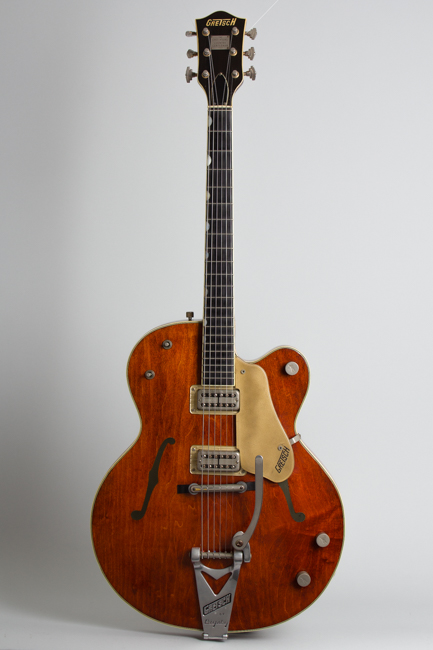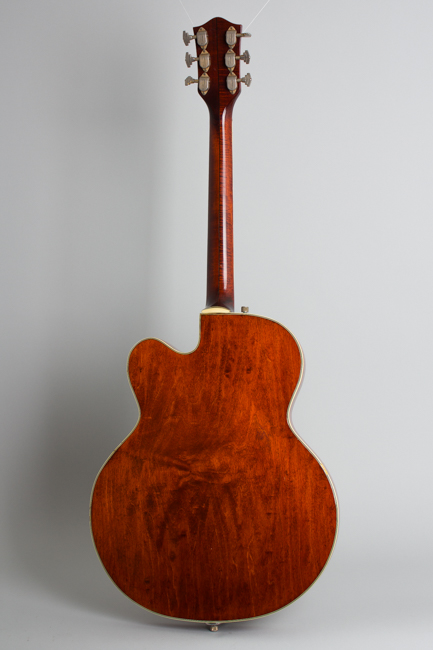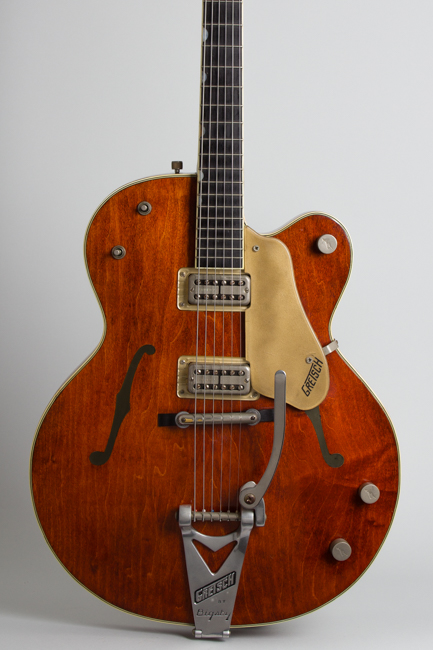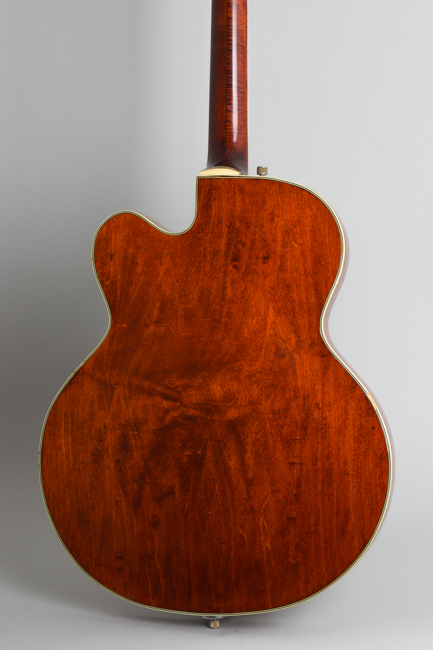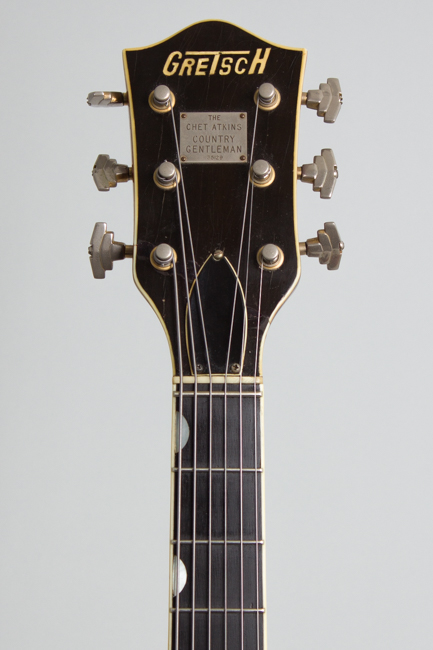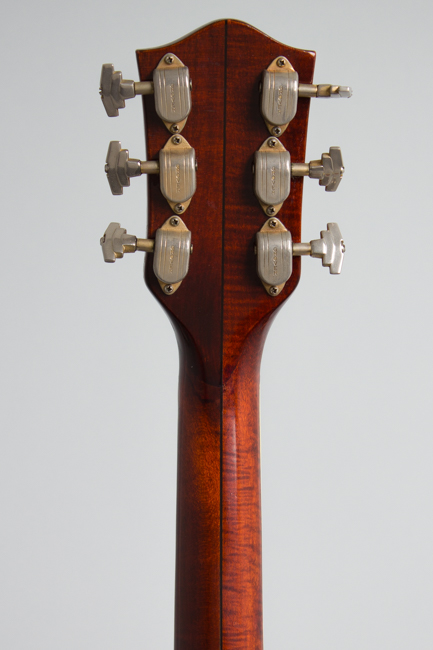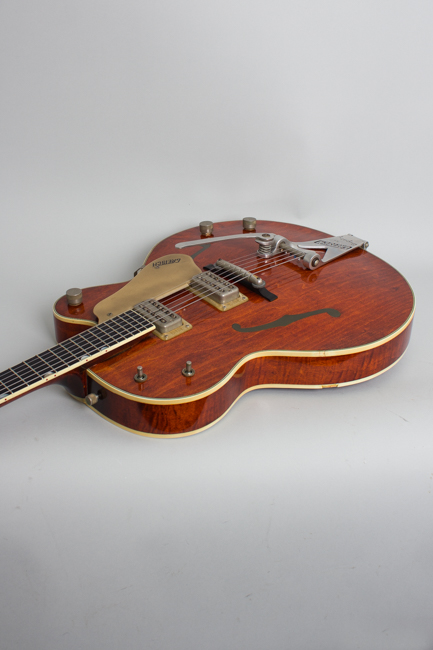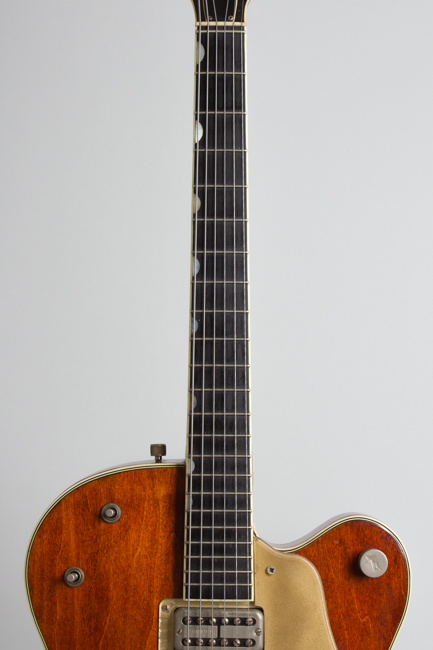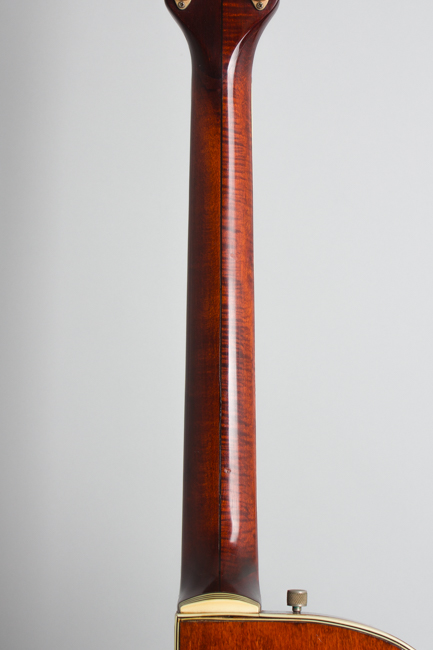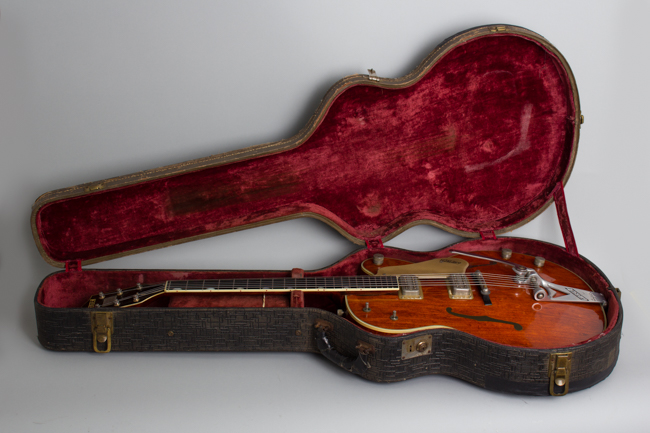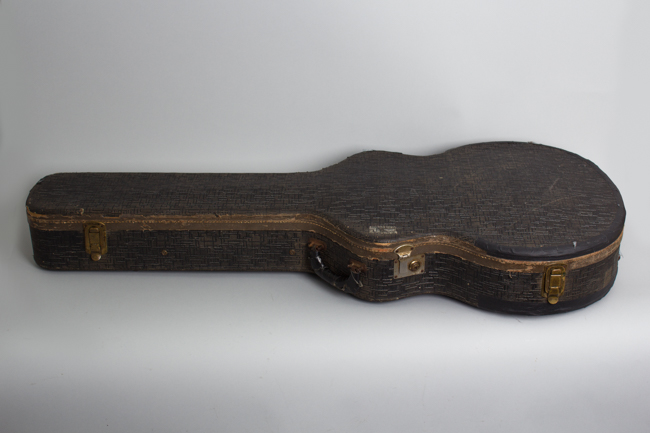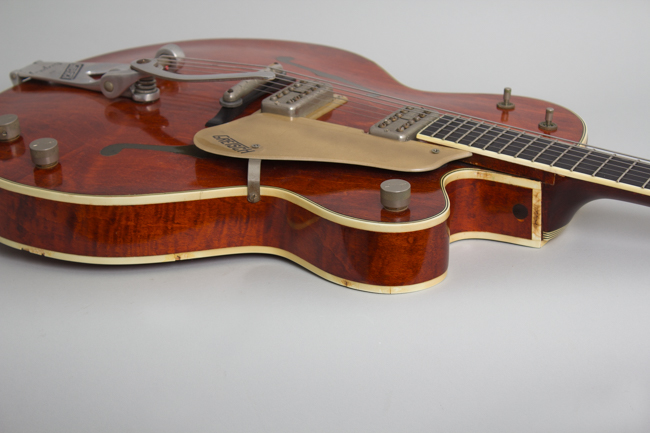Gretsch PX 6122 Country Gentleman Thinline Hollow Body Electric Guitar (1960)
Price reduced!
This item is currently on hold.
Item # 12381
Prices subject to change without notice.
Gretsch PX 6122 Country Gentleman Model Thinline Hollow Body Electric Guitar (1960), made in Brooklyn, NY, serial # 35129, walnut grain lacquer finish, laminated maple body and neck, ebony fingerboard, original two-tone hard shell case.
This is a good player's example of one of the true classic Gretsch instruments from the company's finest era; a Chet Atkins Country Gentleman from early 1960. This one is structurally fine and quite playable but does have an old, solidly repaired headstock break and a fairly early-stage case of the celluloid binding rot that unfortunately is increasingly common on older Gretsch instruments. This is currently affecting only sections of the outer layer of the body binding; the neck looks to have been neatly rebound and the headstock shows no deterioration. The guitar is fully functional and solid and the "disease" appears to have been only slowly progressing so far.
The Chet Atkins Country Gentleman was officially introduced in 1958 as an upscale high-end guitar listing at $525.00; only the White Falcon was priced higher. The "Gent" was the top of the Atkins-endorsed line, produced in limited numbers in the 1950s -- there appear to be only 5 total 50-unit batches before 1960, and perhaps a couple more in this next year. Every 1960 Gent we have seen lately is from this same 351XX batch, the first of the year for 1960.
The Country Gentleman was the Gretsch Chet Atkins himself wanted -- he was less than thrilled with elements of the previous Atkins-signature Hollowbody Model 6120. His endorsement had proved a boon for the company, so they were happy to listen. For this new model he specified a thin-line 17" wide body, deep walnut finish and "closed" f-holes, while keeping the Bigsby tailpiece, metal bridge and 24 1/2" scale from the 6120. Other features included more binding everywhere, "Neo-Classic" position markers on the ebony fingerboard, Grover Imperial tuners and a metal plaque on the headstock with the model name and serial number.
Atkins particularly disliked the DeArmond Dynasonic pickups Gretsch was using, and requested the company use new humbucking units designed by Ray Butts in his signature instruments. Gretsch was happy to oblige and bought the license from Butts to make the new pickups in house for the entire line. This guitar mounts two of these early patent-number "Filter 'Tron" pickups (Gretsch's name for the new units) surrounded by sculpted plastic pickup rings.
The guitar's top is solid with simulated F-holes; this earlier version has plastic insets instead of the decals used later. It also features heavier bracing than earlier Gretsch guitars; both features were requested by Atkins intended to increase sustain and reduce feedback. The Gretsch-logo Bigsby tailpiece on this guitar is a style introduced soon before it was made, replacing the older Bigsby-branded one.
The first-generation single-cutaway Country Gentleman is a fairly rare guitar. The design was altered in 1962 with a double cutaway body, and after the Beatles arrival in the US in 1964 with George Harrison playing one sales went through the roof. The early style "Gent" like this remained the instrument preferred by Atkins himself for both recording and live use throughout the late 1950's and 1960's. the "Gent" is a classy instrument by any standard and one that certainly captures the signature Atkins sound and vibe. Despite the areas of binding loss this remains a fine playing and sounding guitar.
Overall length is 42 1/2 in. (108 cm.), 17 in. (43.2 cm.) wide at lower bout, and 2 1/4 in. (5.7 cm.) in depth, measured at side of rim. Scale length is 24 1/2 in. (622 mm.). Width of nut is 1 11/16 in. (43 mm.).
Apart from a visibly repaired headstock break and small sections of loss to the body edge binding this is a generally well-preserved guitar overall. The finish on the body original except for some minor touch-up around the heel from a neck reset. There are small sections of the neck finish re-shot over the headstock repair and at the heel, but the bulk of the neck lacquer is original as well. The thin original lacquer remains relatively clean with some typical light checking and minor play wear, mostly some buckle wear including heavier scuffing in the center of the back.
As with many older Gretsch guitars the neck has been reset, a clean job but a larger multi-laminate heelcap was added. The neck was also neatly refretted with wire a bit taller than the original, and rebound in the correct style including the red side dots. The headstock repair was a fairly serious break completely through running from just below the nut through the low E tuner. This is repaired solidly but visibly and is completely structurally sound. The plastic headstock veneer has been patched and polished out but not overfinished.
The outer layer of binding on the body has small areas chipped off in various spots but has not suffered wholesale deterioration. The piece on the side of the neck heel is the most affected, as is usually the case. The binding on the headstock is solid. The hardware is all original; even the pickguard which shows some discoloration of the gold paint on the underside but has none of the common cracks. There is wear overall to the gold plating, which has a lovely muted patina. The angle on the neck reset is very good and with the slim nut taller frets the guitar plays and sounds excellent. This is far from the cleanest "Gent" we have had but may be the best playing. It includes the worn but solid original deluxe Gretsch OHSC. Overall Very Good Condition.
This is a good player's example of one of the true classic Gretsch instruments from the company's finest era; a Chet Atkins Country Gentleman from early 1960. This one is structurally fine and quite playable but does have an old, solidly repaired headstock break and a fairly early-stage case of the celluloid binding rot that unfortunately is increasingly common on older Gretsch instruments. This is currently affecting only sections of the outer layer of the body binding; the neck looks to have been neatly rebound and the headstock shows no deterioration. The guitar is fully functional and solid and the "disease" appears to have been only slowly progressing so far.
The Chet Atkins Country Gentleman was officially introduced in 1958 as an upscale high-end guitar listing at $525.00; only the White Falcon was priced higher. The "Gent" was the top of the Atkins-endorsed line, produced in limited numbers in the 1950s -- there appear to be only 5 total 50-unit batches before 1960, and perhaps a couple more in this next year. Every 1960 Gent we have seen lately is from this same 351XX batch, the first of the year for 1960.
The Country Gentleman was the Gretsch Chet Atkins himself wanted -- he was less than thrilled with elements of the previous Atkins-signature Hollowbody Model 6120. His endorsement had proved a boon for the company, so they were happy to listen. For this new model he specified a thin-line 17" wide body, deep walnut finish and "closed" f-holes, while keeping the Bigsby tailpiece, metal bridge and 24 1/2" scale from the 6120. Other features included more binding everywhere, "Neo-Classic" position markers on the ebony fingerboard, Grover Imperial tuners and a metal plaque on the headstock with the model name and serial number.
Atkins particularly disliked the DeArmond Dynasonic pickups Gretsch was using, and requested the company use new humbucking units designed by Ray Butts in his signature instruments. Gretsch was happy to oblige and bought the license from Butts to make the new pickups in house for the entire line. This guitar mounts two of these early patent-number "Filter 'Tron" pickups (Gretsch's name for the new units) surrounded by sculpted plastic pickup rings.
The guitar's top is solid with simulated F-holes; this earlier version has plastic insets instead of the decals used later. It also features heavier bracing than earlier Gretsch guitars; both features were requested by Atkins intended to increase sustain and reduce feedback. The Gretsch-logo Bigsby tailpiece on this guitar is a style introduced soon before it was made, replacing the older Bigsby-branded one.
The first-generation single-cutaway Country Gentleman is a fairly rare guitar. The design was altered in 1962 with a double cutaway body, and after the Beatles arrival in the US in 1964 with George Harrison playing one sales went through the roof. The early style "Gent" like this remained the instrument preferred by Atkins himself for both recording and live use throughout the late 1950's and 1960's. the "Gent" is a classy instrument by any standard and one that certainly captures the signature Atkins sound and vibe. Despite the areas of binding loss this remains a fine playing and sounding guitar.
Overall length is 42 1/2 in. (108 cm.), 17 in. (43.2 cm.) wide at lower bout, and 2 1/4 in. (5.7 cm.) in depth, measured at side of rim. Scale length is 24 1/2 in. (622 mm.). Width of nut is 1 11/16 in. (43 mm.).
Apart from a visibly repaired headstock break and small sections of loss to the body edge binding this is a generally well-preserved guitar overall. The finish on the body original except for some minor touch-up around the heel from a neck reset. There are small sections of the neck finish re-shot over the headstock repair and at the heel, but the bulk of the neck lacquer is original as well. The thin original lacquer remains relatively clean with some typical light checking and minor play wear, mostly some buckle wear including heavier scuffing in the center of the back.
As with many older Gretsch guitars the neck has been reset, a clean job but a larger multi-laminate heelcap was added. The neck was also neatly refretted with wire a bit taller than the original, and rebound in the correct style including the red side dots. The headstock repair was a fairly serious break completely through running from just below the nut through the low E tuner. This is repaired solidly but visibly and is completely structurally sound. The plastic headstock veneer has been patched and polished out but not overfinished.
The outer layer of binding on the body has small areas chipped off in various spots but has not suffered wholesale deterioration. The piece on the side of the neck heel is the most affected, as is usually the case. The binding on the headstock is solid. The hardware is all original; even the pickguard which shows some discoloration of the gold paint on the underside but has none of the common cracks. There is wear overall to the gold plating, which has a lovely muted patina. The angle on the neck reset is very good and with the slim nut taller frets the guitar plays and sounds excellent. This is far from the cleanest "Gent" we have had but may be the best playing. It includes the worn but solid original deluxe Gretsch OHSC. Overall Very Good Condition.
